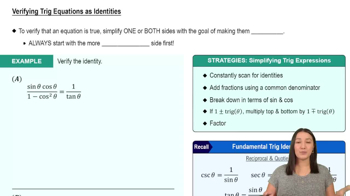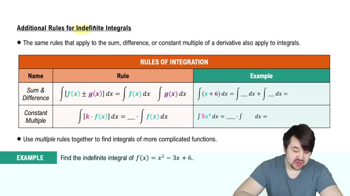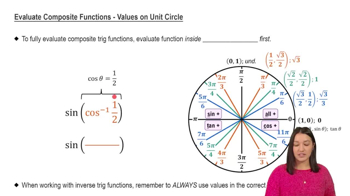A triangle has side c = 2 and angles A = π/4 and B = π/3. Find the length a of the side opposite A.
Table of contents
- 0. Functions7h 54m
- Introduction to Functions16m
- Piecewise Functions10m
- Properties of Functions9m
- Common Functions1h 8m
- Transformations5m
- Combining Functions27m
- Exponent rules32m
- Exponential Functions28m
- Logarithmic Functions24m
- Properties of Logarithms36m
- Exponential & Logarithmic Equations35m
- Introduction to Trigonometric Functions38m
- Graphs of Trigonometric Functions44m
- Trigonometric Identities47m
- Inverse Trigonometric Functions48m
- 1. Limits and Continuity2h 2m
- 2. Intro to Derivatives1h 33m
- 3. Techniques of Differentiation3h 18m
- 4. Applications of Derivatives2h 38m
- 5. Graphical Applications of Derivatives6h 2m
- 6. Derivatives of Inverse, Exponential, & Logarithmic Functions2h 37m
- 7. Antiderivatives & Indefinite Integrals1h 26m
- 8. Definite Integrals4h 44m
- 9. Graphical Applications of Integrals2h 27m
- 10. Physics Applications of Integrals 3h 16m
- 11. Integrals of Inverse, Exponential, & Logarithmic Functions2h 31m
- 12. Techniques of Integration7h 41m
- 13. Intro to Differential Equations2h 55m
- 14. Sequences & Series5h 36m
- 15. Power Series2h 19m
- 16. Parametric Equations & Polar Coordinates7h 58m
0. Functions
Trigonometric Identities
Problem 1.3.42
Textbook Question
In Exercises 39–42, express the given quantity in terms of sin x and cos x.
cos (3π/2 + x)
 Verified step by step guidance
Verified step by step guidance1
Recognize that the expression cos(3π/2 + x) involves a trigonometric identity for cosine of a sum, which is cos(a + b) = cos(a)cos(b) - sin(a)sin(b).
Identify the values of a and b in the expression: here, a = 3π/2 and b = x.
Substitute these values into the identity: cos(3π/2 + x) = cos(3π/2)cos(x) - sin(3π/2)sin(x).
Recall the exact trigonometric values: cos(3π/2) = 0 and sin(3π/2) = -1.
Substitute these values back into the expression: cos(3π/2 + x) = 0 * cos(x) - (-1) * sin(x), which simplifies to sin(x).
 Verified video answer for a similar problem:
Verified video answer for a similar problem:This video solution was recommended by our tutors as helpful for the problem above
Video duration:
2mPlay a video:
Was this helpful?
Key Concepts
Here are the essential concepts you must grasp in order to answer the question correctly.
Trigonometric Identities
Trigonometric identities are equations that involve trigonometric functions and are true for all values of the variables involved. They are essential for simplifying expressions and solving equations in trigonometry. Key identities include the Pythagorean identity, angle sum and difference identities, and double angle formulas, which help express trigonometric functions in various forms.
Recommended video:

Verifying Trig Equations as Identities
Angle Addition Formulas
Angle addition formulas are specific trigonometric identities that express the sine and cosine of the sum or difference of two angles. For example, the cosine of the sum of two angles is given by cos(a + b) = cos(a)cos(b) - sin(a)sin(b). These formulas are crucial for transforming expressions involving sums of angles into simpler forms using basic trigonometric functions.
Recommended video:

Additional Rules for Indefinite Integrals
Unit Circle
The unit circle is a circle with a radius of one centered at the origin of a coordinate plane. It is a fundamental tool in trigonometry, as it provides a geometric interpretation of the sine and cosine functions. The coordinates of points on the unit circle correspond to the values of cosine and sine for various angles, making it easier to evaluate trigonometric functions for any angle.
Recommended video:

Evaluate Composite Functions - Values on Unit Circle

 6:36m
6:36mWatch next
Master Simplifying Trig Expressions with a bite sized video explanation from Patrick
Start learningRelated Videos
Related Practice
Textbook Question
